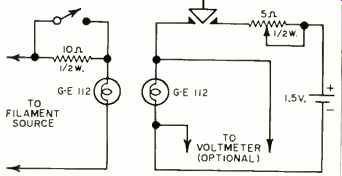(source: Electronics World, Aug. 1964)
ONE of the major problems associated with certain types of high-voltage rectifiers is that sometimes it is difficult to tell when the filament is lit, and if it is, then we have to guess at the filament voltage.
A recent issue of G-E "Techni-Talk" shows a simple way to measure this voltage using the circuit shown. It consists of matching the brilliancy of a bulb deriving its filament voltage from the high-voltage rectifier socket, with the brilliancy of a bulb drawing power from a dry cell. When the brilliancy of the two bulbs is matched, the amount of battery voltage should be about the same as the voltage from the socket. Accuracies of 0.1 volt have been attained.
Insulated high-voltage leads are used to interconnect the filament test bulb with the high-voltage rectifier socket.
Place the anode high-voltage lead in a safe place. The 10-ohm resistor in parallel with the s.p.s.t. switch is used to measure a wide range of filament voltages. With this resistor shorted, up to 1.5v. can be measured. With the resistor in the circuit, up to 3.6 v. can be measured.

---------The No. 112 lamp is an ordinary 1.2-volt, 0.22 amp, flashlight-type
bulb.
The G-E 112 lamp filament resistance closely approximates a rectifier filament resistance.
When the push-button switch is depressed, the second bulb filament current, hence its brightness, is controlled by the 5-ohm linear potentiometer.
When this bulb filament brightness is adjusted to equal the test bulb filament brightness, the voltmeter will indicate the approximate filament voltage.
With the left-hand switch in the low position (10-ohm resistor shorted) , the voltmeter requires no correction factor.
However, in the high position, 2.1 volts must be added to the meter reading to compensate for loss incurred in the 10ohm dropping resistor.
It should be pointed out that this device does not actually measure the filament source voltage, but indicates how much d.c. voltage is required to make the power input of one lamp equal that of another, matched, lamp.